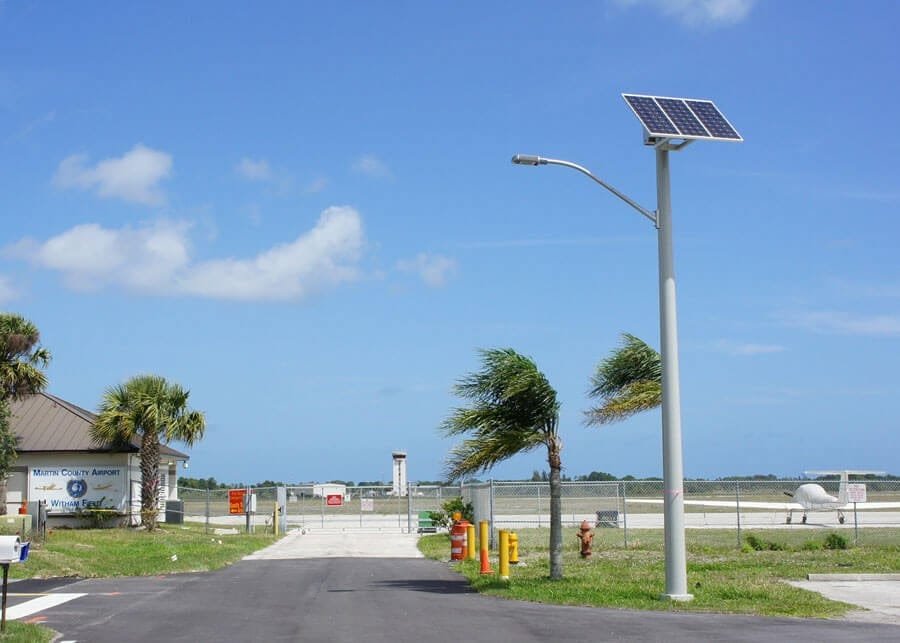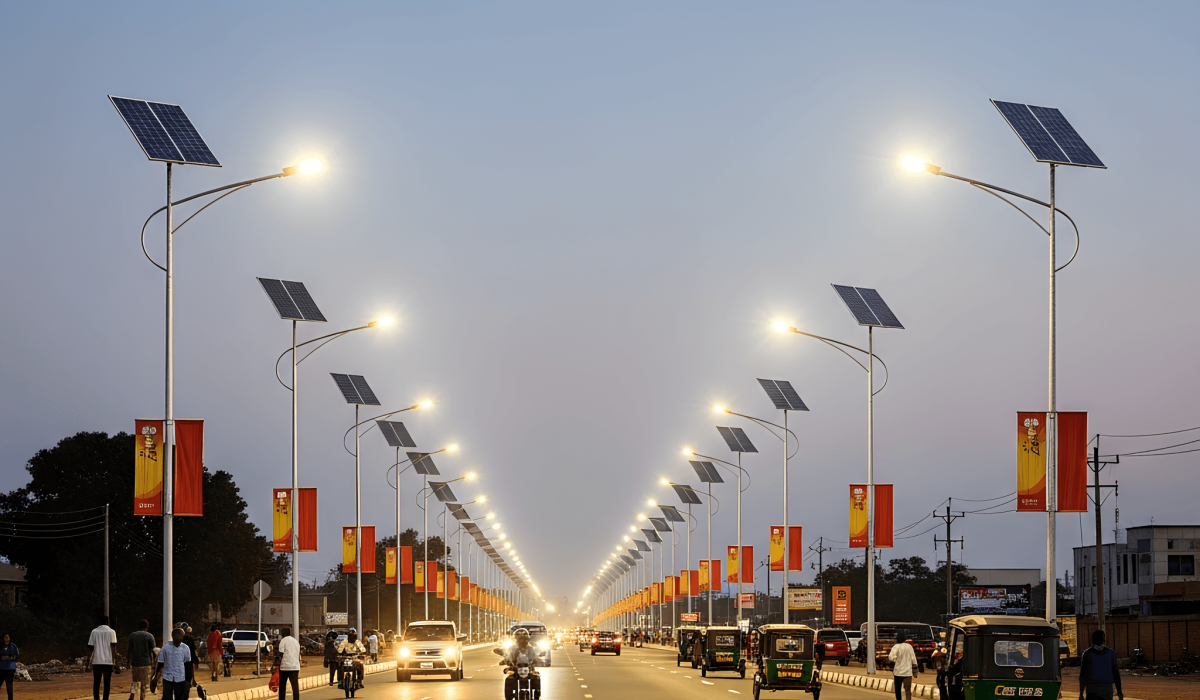Solar street lights are self-sustaining outdoor lighting systems that use solar panels to convert sunlight into electricity, store it in batteries, and automatically power high-efficiency LED lamps at night—without relying on the grid. In 2024, they’re widely adopted across Africa for rural roads, estates, parks, and humanitarian projects due to their zero energy costs, quick installation, and low maintenance. Compared to traditional grid lights, solar street lights offer faster deployment, greater resilience to outages, and up to 70% lower lifetime costs. The latest models integrate smart controllers, motion sensors, and lithium batteries, making them ideal for governments, EPC contractors, and NGOs seeking long-term, energy-efficient lighting solutions.
Why Are Solar Street Lights Becoming the Future of Outdoor Lighting?
Across Africa, solar street lighting isn’t just a trend—it’s a transformation. Over the past decade, I’ve watched governments, contractors, and NGOs shift from costly grid expansion to decentralized, energy-efficient lighting. Today, solar street lights stand at the center of this evolution.
In 2024, the demand for low-maintenance, off-grid public lighting is at an all-time high—driven by urban growth, infrastructure funding gaps, and energy security concerns. From Kigali to Kano, I’ve walked project sites where solar lighting turned dangerous, unlit roads into vibrant, secure public corridors.
This guide brings together everything I’ve learned in the field—how solar street lights work, what components matter, how they compare to traditional lighting, and where they make the most sense. Whether you're bidding on an EPC tender or designing a rural lighting plan, this is the practical knowledge you need.
How Do Solar Street Lights Work Step by Step?

Solar street lights work by converting sunlight into electricity during the day and storing it in batteries to power LED lights at night—without requiring any grid connection.
Here’s a simplified breakdown of the daily cycle:
- Sunlight hits the solar panel, generating direct current (DC) electricity.
- The controller regulates this power flow and stores energy in the lithium or GEL battery.
- At dusk, the controller triggers the LED lamp to switch on, using the stored energy.
- At dawn, the system shuts down, ready for another cycle.
In most of my projects, motion sensors or dimming profiles are programmed to save power, especially in low-traffic areas. Advanced controllers can also monitor temperature, adjust brightness, and report battery health remotely—critical for large-scale deployments.
Key takeaway: The beauty of solar lighting lies in its autonomy—no trenches, no cables, no electricity bills.
What Are the Core Components of a Solar Street Light System?
Every solar street light system is built from four key components: the LED light source, the solar panel, the battery, and the controller. Understanding each helps you evaluate product quality and performance over time.
1. LED Light Source
- Efficiency: Modern LEDs offer 150–200 lm/W, drastically reducing power consumption.
- Color Temperature: 3000K–6500K options depending on use case (residential, urban roads, etc.).
- Lens Design: I’ve specified beam angles and IES files for contractors needing precise lighting coverage.
2. Solar Panel
- Monocrystalline Panels: Up to 22% efficiency and excellent in high-heat environments.
- Tilt Angle Optimization: Panels must face the equator (north in southern hemisphere) for max yield.
- Size Matters: Don’t undersize panels—shade and cloudy days can cut output by 40%.
3. Battery System
- Lithium (LiFePO4): My go-to choice—lightweight, 2000+ cycles, and better depth of discharge.
- GEL/AGM Lead-Acid: More affordable but heavier and shorter life.
- Battery Placement: Integrated (in the lamp body) or underground for anti-theft protection.
4. Smart Controller
- Functions: On/off timing, dimming schedules, motion sensor inputs, and fault reporting.
- MPPT Charging: Improves solar efficiency by up to 30% compared to PWM.
- Remote Monitoring: Ideal for municipalities—track performance, identify faults instantly.
From my experience: Cutting corners on the controller or battery is the fastest way to ruin a good solar light.
How Do Solar Street Lights Compare with Traditional Grid Lighting?

Let’s look at the real differences across cost, installation, maintenance, and performance.
| Feature | Traditional Street Light | Solar Street Light (Sunlurio) |
|---|---|---|
| Energy Source | Grid electricity | Sunlight (100% renewable) |
| Installation | Trenching, cabling required | Pole-mounted, no trenching |
| Power Outage Risk | High (dependent on grid) | Zero (off-grid autonomy) |
| Electricity Bills | Monthly recurring costs | None |
| Maintenance | Complex, specialized crews | Minimal, with remote alerts |
| Initial Cost | Lower upfront cost | Higher upfront, but no OPEX |
| Long-Term ROI | 5–7 years | 2–4 years |
Bottom line: While solar may cost more upfront, the total cost of ownership is dramatically lower—especially across 3–5 year project lifespans.
Where Are Solar Street Lights Being Used Most Effectively?
Solar street lights are being deployed across a wide range of use cases—from urban expansion to humanitarian aid.
s in Rural Highway](https://sunlurio.com/wp-content/uploads/2025/03/664c570b780c1c6168880a9e_lightgogo-4-all-in-one-solar-street-light-installation-in-express-way-1024x576.webp)
1. Rural Roads & Villages
- No grid needed. Installation is quick—ideal for electrification programs.
- In Tanzania, we lit a 12 km corridor where utility access was years away.
2. Urban Housing Estates
- Adds value and safety to gated communities and public housing blocks.
- Motion sensors help manage consumption in low-traffic residential areas.
3. Public Parks & Walkways
- Aesthetically integrated lights improve security and usability after dark.
- Battery backup ensures all-night lighting even during bad weather.
4. Humanitarian Projects
- UN and NGOs deploy solar lights in camps for displaced persons.
- Quick relief deployment. Low-risk installation.
5. Parking Areas & Institutions
- Universities, hospitals, and office parks value the green credentials and operational cost savings.
Tip for EPC contractors: Highlight multi-application capability in tenders. It adds weight to your proposal beyond just specs.
What Solar Street Light Products Does Sunlurio Offer in 2024?
At Sunlurio, we engineer solar street lighting systems built for African conditions.
🌞 SLL-Pro Series
- All-in-One Design with LiFePO4 battery and high-lumen LED.
- 40W–120W models available.
- Ideal for housing estates, councils, and medium-traffic roads.
🔧 SLL-Alpha Modular Series
- Separated panel and battery for high-heat and high-shading areas.
- MPPT controller + remote app monitoring.
- Scalable from 60W–150W.
🔒 SLL-Security Series
- Motion-sensing, dimming-ready, and tamper-resistant.
- Perfect for institutions, border posts, and camps.
All Sunlurio lights come with 5-year warranties, anti-corrosion aluminum bodies, and easy pole mounting kits—designed for African EPCs needing durability and speed.
How Did Sunlurio Help Light Up a Community in Nigeria?
In 2023, we partnered with a local EPC contractor to deliver 180+ solar street lights in Enugu State, Nigeria.

The project covered two highways and four schools, providing reliable lighting after years of outages and cable theft. Using our SLL-Pro 80W series, we completed installation in 14 days—with zero grid connection.
“Sunlurio’s modular system saved us weeks on trenching and inspection.” —Project Manager, Enugu EPC
Local feedback has been overwhelmingly positive. Crime along the highway dropped. Schools extended evening hours. And the client has returned for two new districts.
Ready to Upgrade Your Outdoor Lighting?
Solar street lighting isn’t just a product—it’s a strategy.
Whether you're rolling out a nationwide electrification plan or lighting a school road, Sunlurio has the systems, support, and speed to help you deliver. Let's build your next solar lighting project together.
👉 Contact Sunlurio Now for specs, pricing, or a free project consultation.


